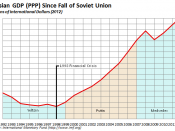Following the break-up of the hyper centralized Soviet Union, there was fragmentation among Russia's regions, and contesting definitions of sovereignty. Under Yeltsin there was an asymmetrical growth in the federal authorities, with regions being given free reign so long as secession was not threatened. This principle of granting local privileges in return for loyalty was not a new concept; indeed it was practiced by the Ottoman and Hapsburg empires. However this tolerance of regional governance allowed the consolidation of political ethnic groups while also permitting authoritarian regimes. On the 11th May 2000 Putin began issuing the first presidential decrees to combat the destructive nature of competition between the center and the regions. To understand the urgency of decrees that were issued six weeks after taking office we have to examine the state of the relationship between the center and the regions. From this understanding, Putin's reforms of the system will then be analysed.
Conflicts in center-periphery relations in Russia arose early in the post-soviet reform process. The legislatures created through popular election in 1990 introduced the notion of accountability to local politics. If regional legislators were to be held responsible by constituents for the political and economic conditions of their regions, they wanted more control over key policy instruments. This period was punctuated by the frequent practice of regional governments withholding tax revenues from federal authorities, and periodic refusals on the part of some regions to follow central policy prescriptions in areas such as privatization.
In part, the particularly confrontational years of center-periphery relations (in particular, from 1990/1 through 1993) stemmed from divergent views regarding the appropriate distribution of power between levels of government. The center favored a national federal system, a type of "federalism from above" or presidential vertical, where the central government would clearly take the lead in...


